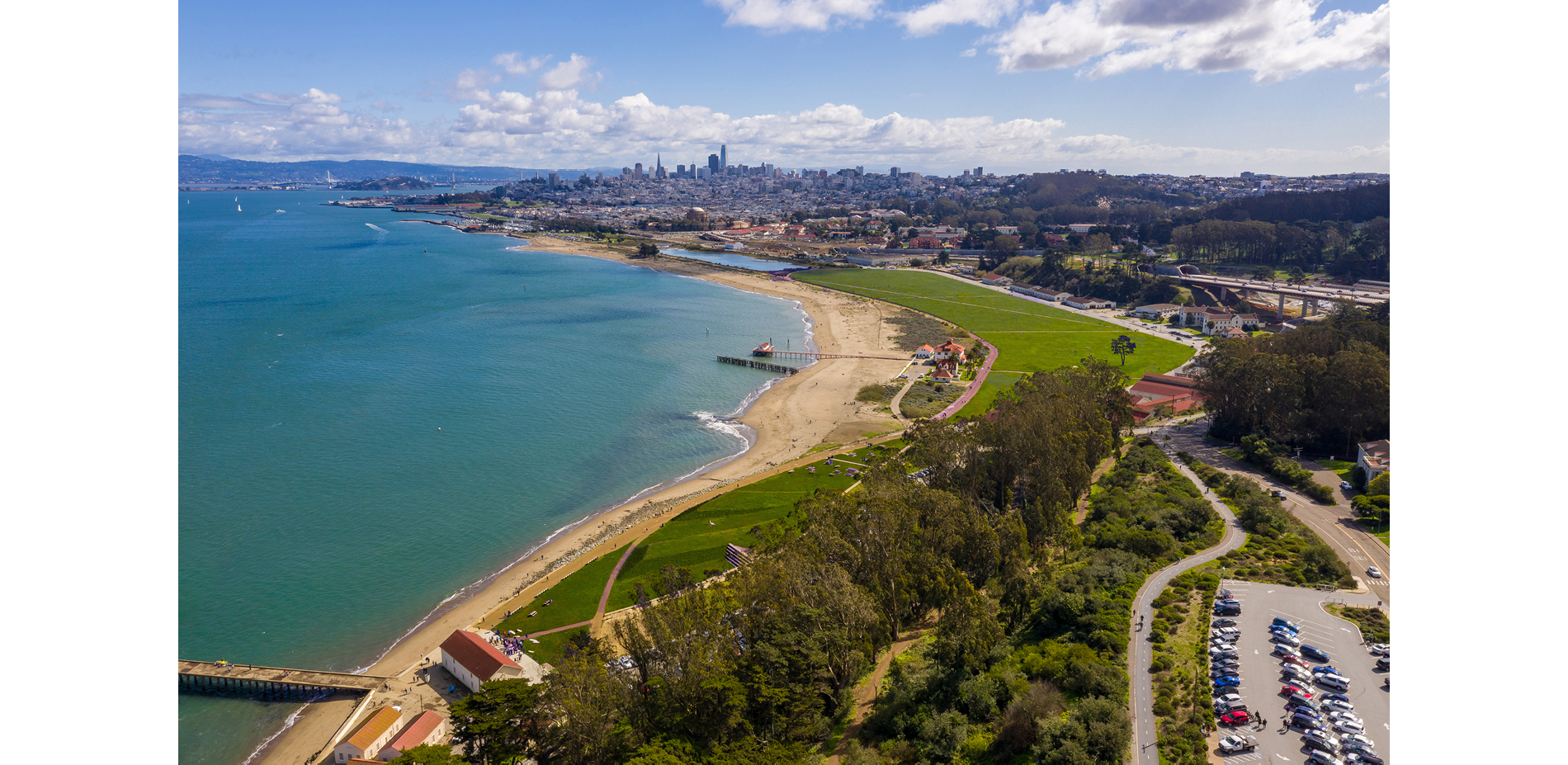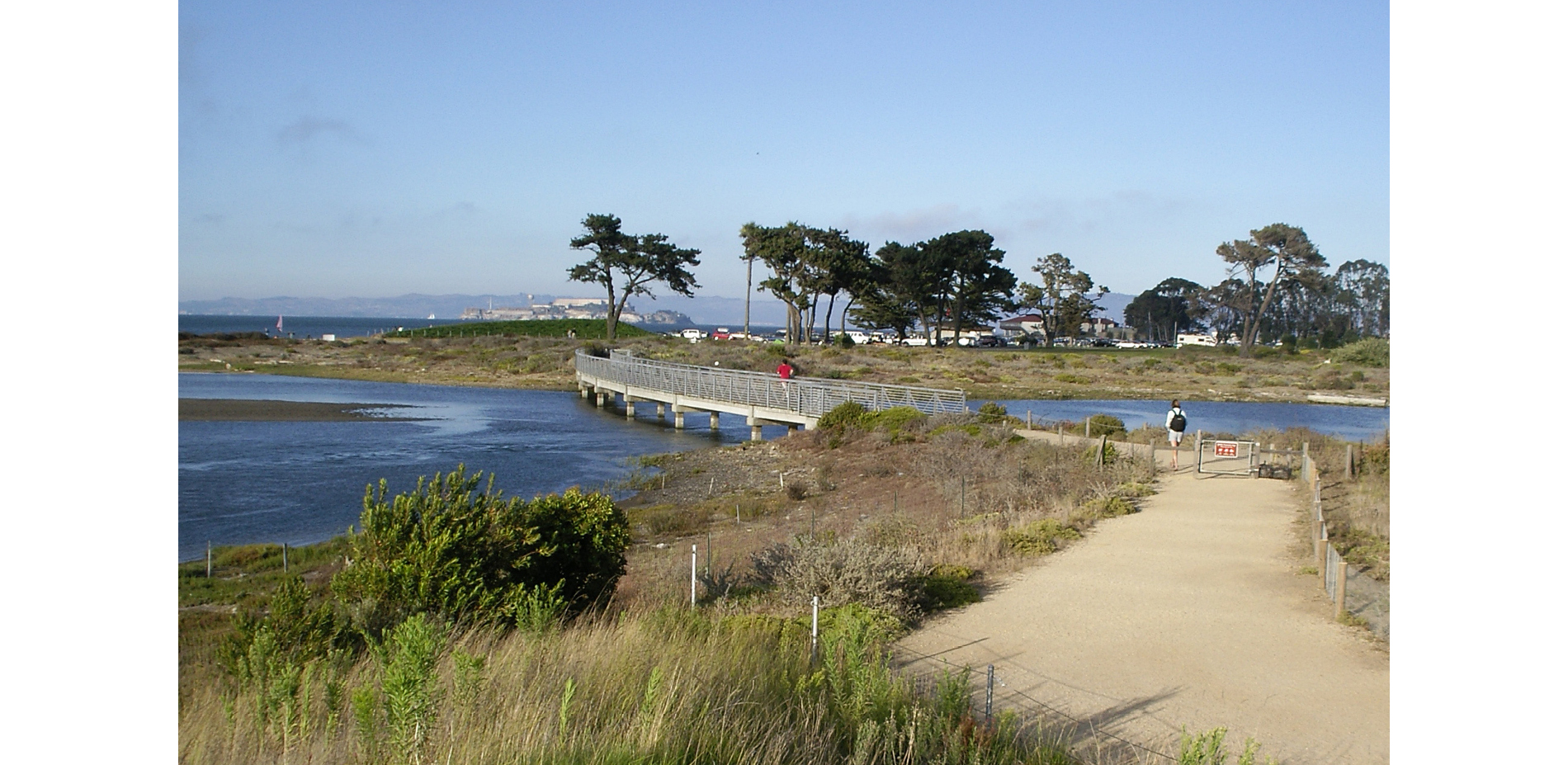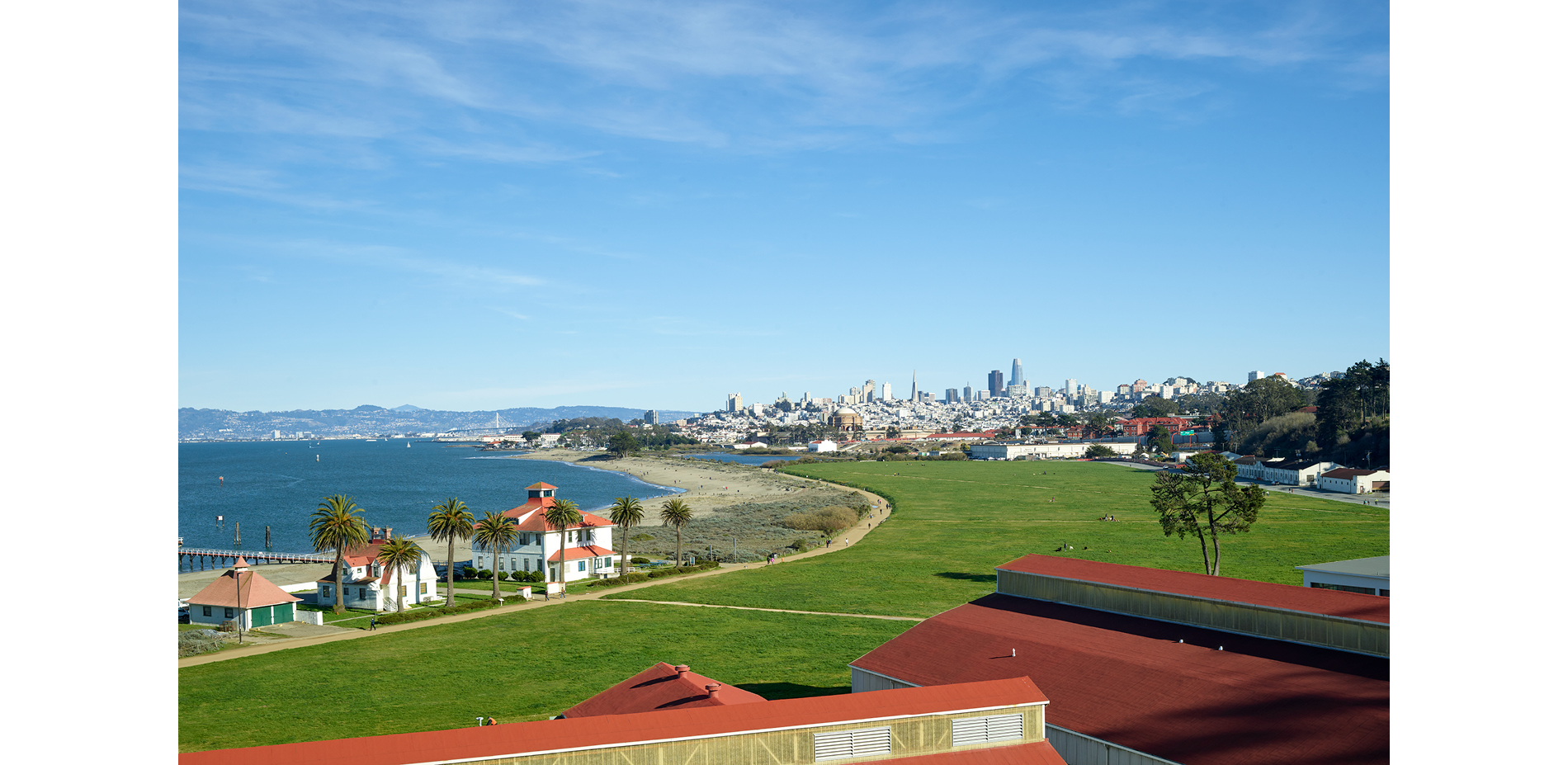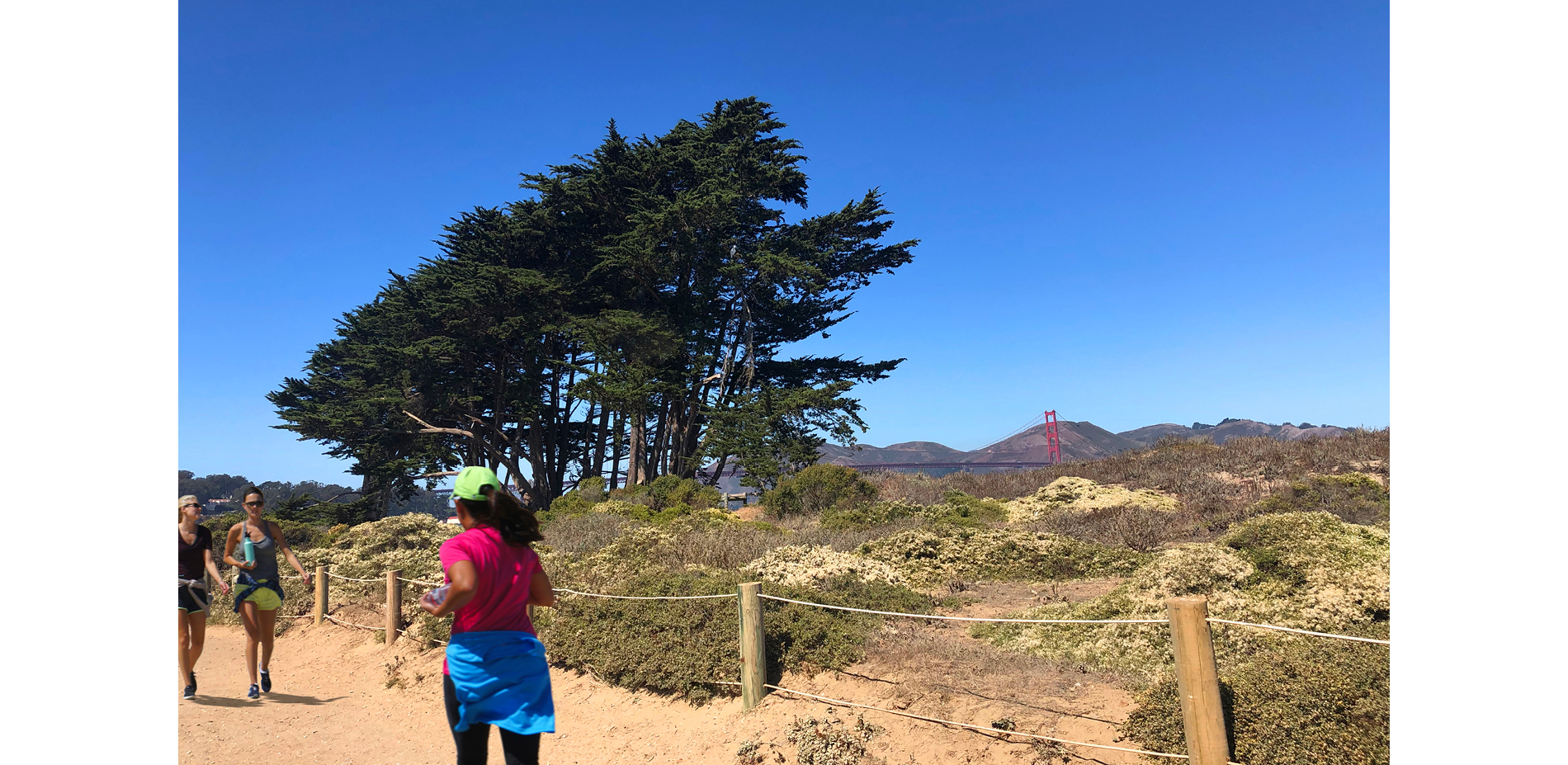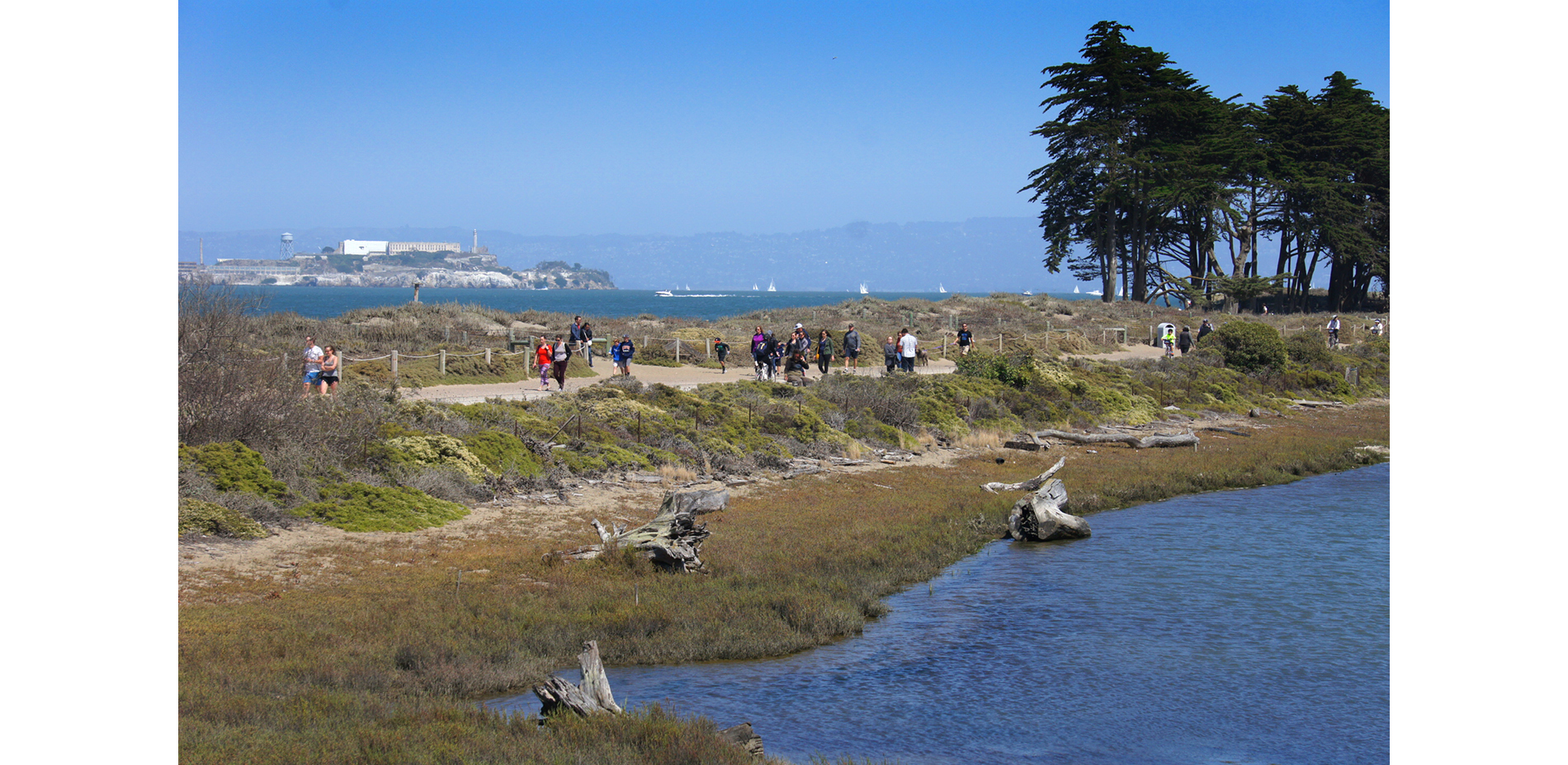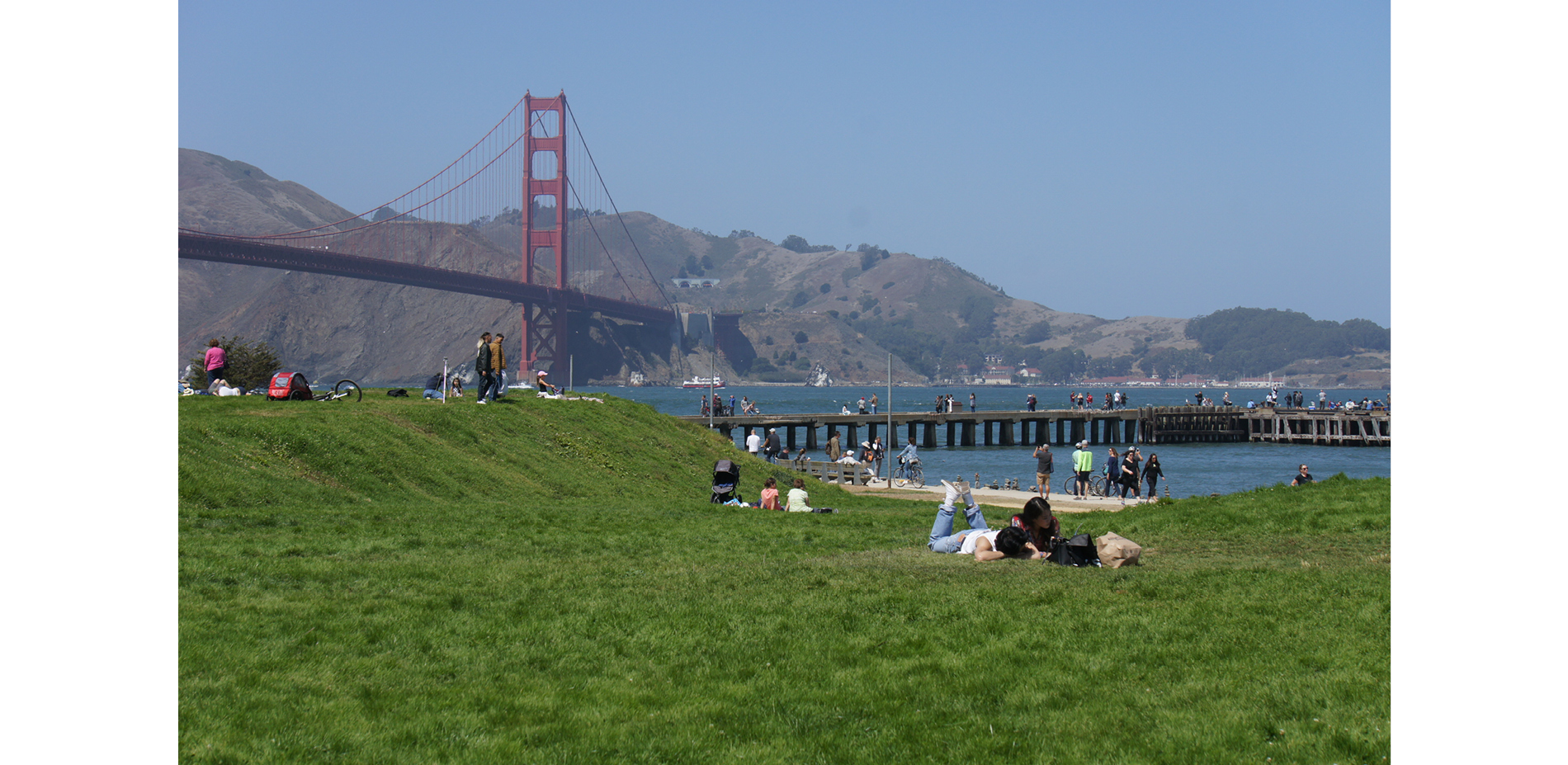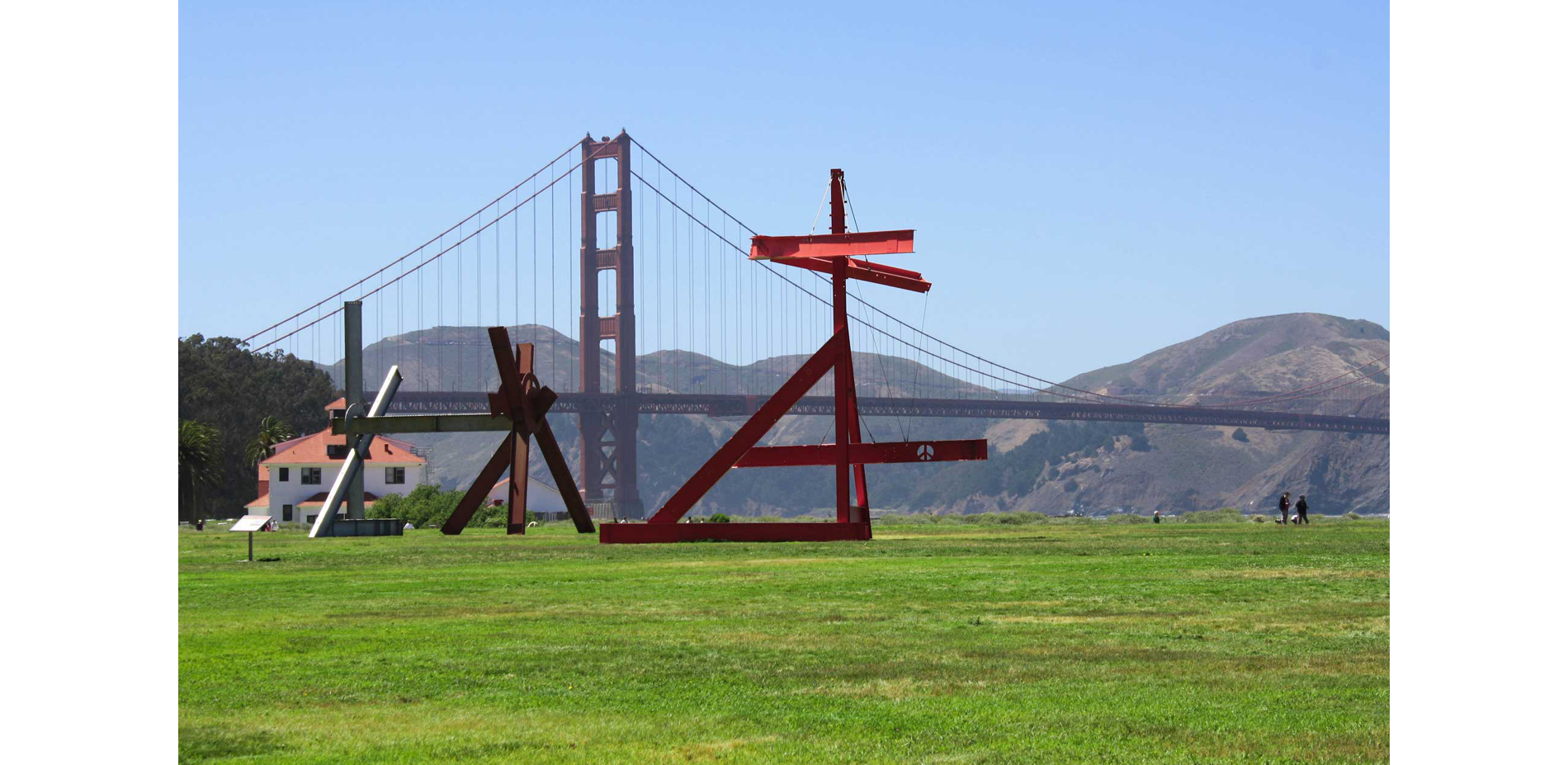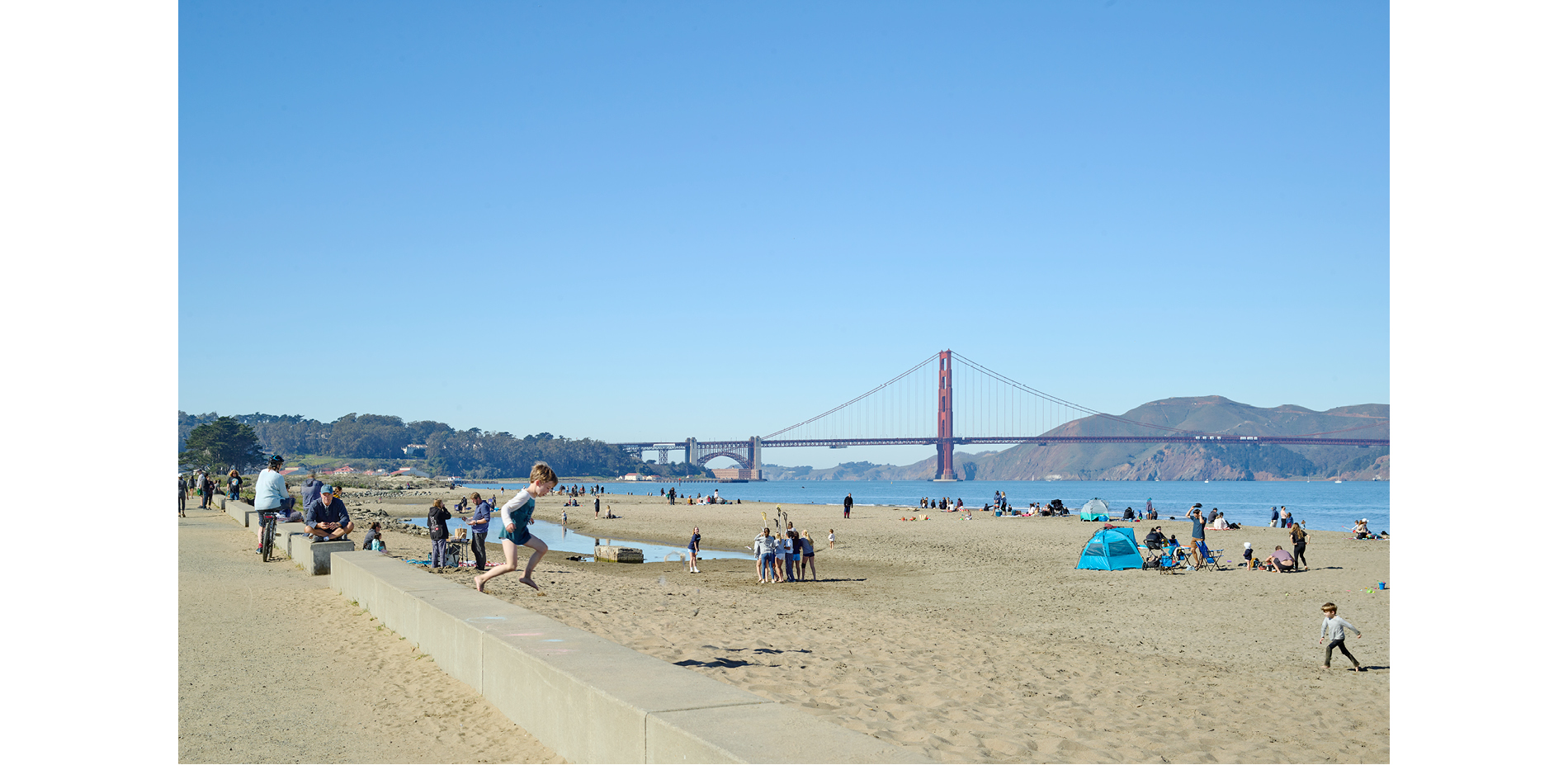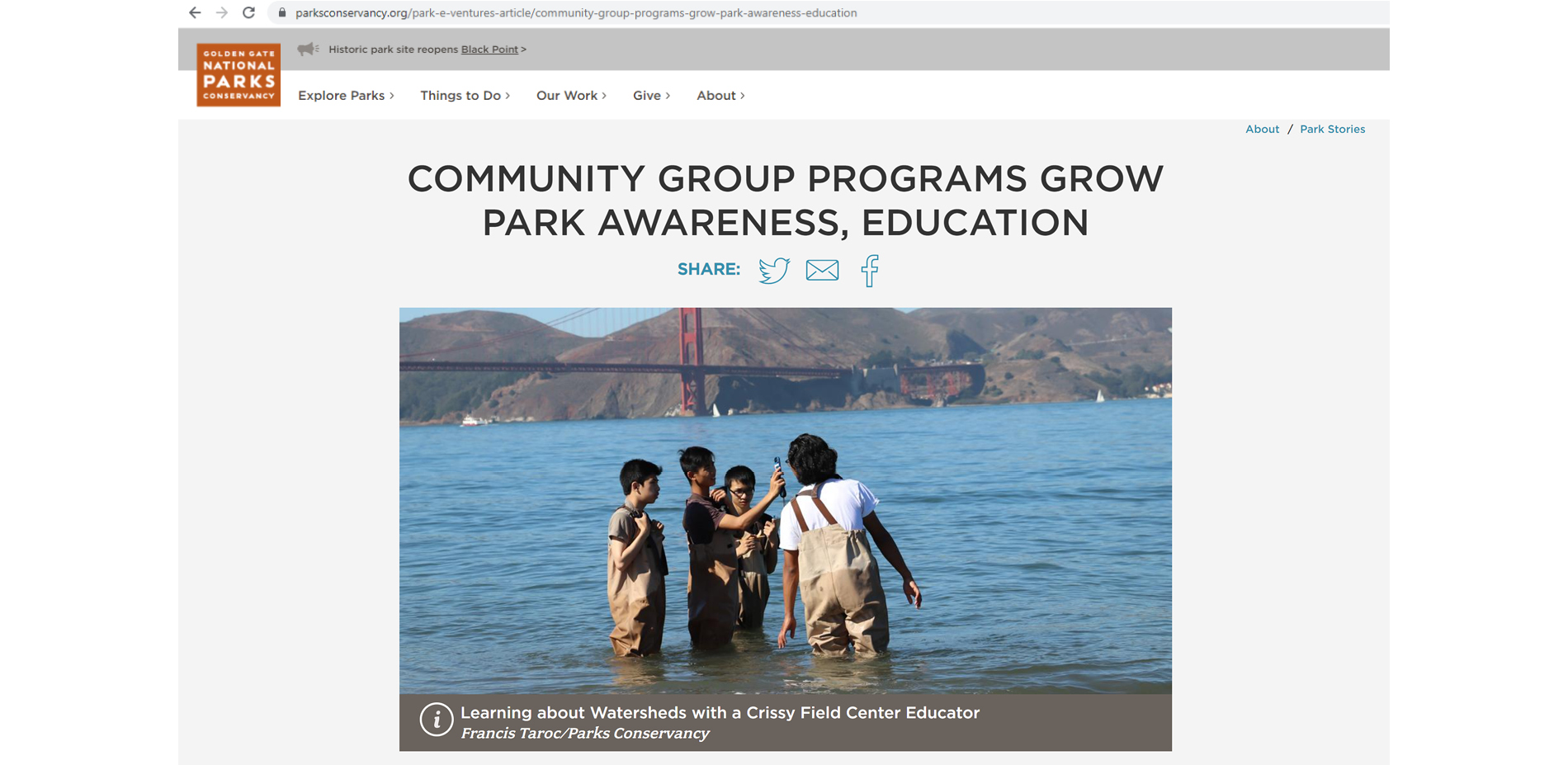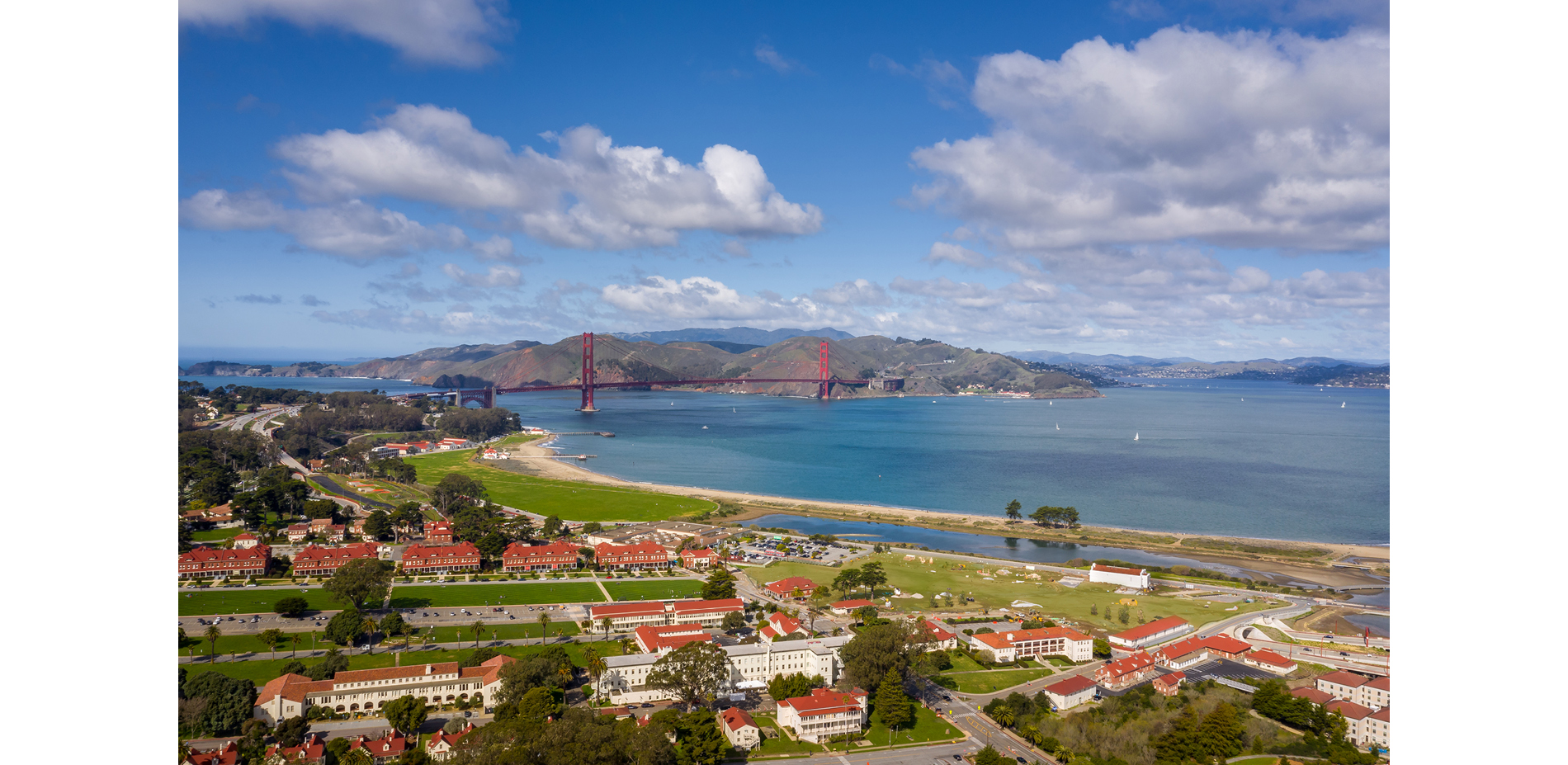Crissy Field: An Enduring Transformation
Landmark Award
The Landmark Award
San Francisco, California, United States
Hargreaves Jones
Client: Golden Gate National Parks Conservancy
While reintroducing and amplifying the natural and cultural features of the site, the project restored 40 acres of habitat consisting of 22 acres of vegetated dune and dune swale habitat and 18 acres of tidal marsh, allowing fresh and salt water to merge. A 1.5-mile promenade alongside an extensive protected coastal dune habitat unifies the site. And the Crissy Field Center supports a variety of education and outreach programs for youth. The jury lauded it as a culturally and ecologically effective icon. A city-defining landscape amenity.
- 2022 Awards Jury
Project Credits
George Hargreaves, Design Director at Hargreaves Jones
Mary Margaret Jones, President at Hargreaves
Kirt Rieder, Principal at Hargreaves Jones
Catherine Miller, Principal at Hargreaves Jones
Golden Gate Parks National Conservancy, Lead Agency
Moffatt & Nichol Engineers, Civil and Marine Engineers
Philip Williams and Associates, Hydrology
E.G. Hirsch & Associates, Structural Engineering
Russell D. Mitchell & Associates, Irrigation
Rana Creek Habitat Restoration, Restoration Ecology
Tanner, Leddy, Maytum, Stacy Architects, Local Architect
Project Statement
Since opening in 2001, Crissy Field has become an iconic destination in San Francisco for over 1 million visitors each year. The dramatic site at the base of the Golden Gate Bridge was historically tidal marsh, then filled for the 1915 Pan-Pacific Exposition, later occupied by the U.S. Army, and finally transferred to the National Park Service – at that time, a neglected site comprised of 45 acres of asphalt, miles of chain link fence, and abandoned buildings.
The design transformed the site into a 100-acre national park, the first urban park in the system, and restored 44 acres of habitat, including an 18-acre tidal marsh. Its design challenges notions of urban wilderness as an either/or proposition, creating a hybrid space in which both cultural and ecological systems thrive, immersing visitors in a reestablished tidal marsh, coastal dune field and a restored grass airfield. This vibrant urban park attracts hikers, bikers, runners, windsurfers, paragliders, dogwalkers, school groups and families from the Bay Area and across the globe.
Project Narrative
Few places in San Francisco reflect contemporary public life yet contain as rich cultural and ecological narratives as Crissy Field. The design was heavily informed by primary source, archival research which revealed an extensive backdune tidal marsh used by the native Ohlone people prior to European settlement in the late 17th century. The marsh was filled in the 19th century for use during the 1915 Panama-Pacific International Exposition and then by the U.S. Army for their military installation. In 1994 the site was decommissioned and transferred to the National Park Service (NPS).
Traces of these man-made features and patterns of use remain. This palimpsest was a primary catalyst for the park’s design, with no one period of history dominating but rather many periods overlain on one another. The result is a hybrid space that is both a biodiverse ecological hotspot and intensely used and beloved urban waterfront park.
Community Context
Crissy Field is located along a northern portion of San Francisco Bay adjacent to residential neighborhoods, two marinas, and the Presidio, a 1,500-acre military post which has been repurposed as a mixed-use development of park, habitat, trails, residential, office, and commercial spaces.
In addition to a deeply complex, polluted site, the designers found passionate constituents who had differing ideas for the park. There were those who valued the site for its significance to military aviation history, environmentalists who wanted to restore the tidal marsh, and boardsailors and dog walkers who wanted to expand their activities. All felt that their preferred use should prevail. As the transition from informal use to a public park began, an extensive public process unfolded over the course of two years including 25 community meetings and multiple reviews by legislating agencies. Through compromise and consensus, integrating both ecological habitat and recreation became the overarching goal.
Crissy Field’s design creates a balance of program, history, and ecology, juxtaposing these seemingly incompatible uses. The site is united by a 1.5-mile promenade that provides sweeping views to the San Francisco Bay and access to the spectrum of park uses. Wildlife areas are not segregated or removed from the promenade experience. Sectional grade changes and fencing hidden by planting allow the fragile tidal marsh to share its boundary with areas of active recreation. The changing textures, colors, and tidal cycles of the habitat areas are witnessed over time, through daily or weekly visits. The dynamic rhythms of human and non-human life are comingled, heightening one's understanding of the cultural and ecological significance of the site.
The park was also designed with a focus on education. The park’s Crissy Field Center supports a variety of education and outreach programs including youth camping, community group programs, high school leadership programs, youth environmental science programs, summer camps, and field trips. In 2018 alone, over 16,000 children from 70 different schools were served.
Historic Traces
The tidal marsh that once dominated the site was re-established on the eastern side of the park along with coastal dune fields and a public beach. Excavated fill from creating of the marsh was reused to create the dunes as well as recreate the historic grass airfield, which is now a flexible event space supporting a variety of large-scale activities. The kidney bean shape of the airfield is derived from a wooden automobile racetrack built for the 1915 Panama-Pacific International Exposition.
Urban Wilderness
The project restored 40 acres of habitat consisting of 22 acres of vegetated dune and dune swale habitat and 18 acres of tidal marsh, allowing fresh and salt water to merge at Crissy Field for the first time in 100 years. The restoration of dune and marsh habitats reintroduced nearly 100,000 plants comprised of 110 native species, including seven special status species such as San Francisco Spineflower (Chorizanthe cuspidata var. cuspidate), Dune Gilia (Gilia capitata ssp. chamissonis), and San Francisco Wallower (Erysimum franciscanum).
The marsh and lagoon support migratory birds along the Pacific Flyway including ducks, pelagic birds, and shorebirds. The federally threatened Western Snowy Plover (Charadrius alexandrinus) roosts on the beach in a Wildlife Protection Area. The Park is a popular bird watching location for citizen scientists participating in eBird and iNaturalist data collection. Over 200 bird species have been identified in the marsh and lagoon alone.
Groundbreaking National Park Service Project
The first urban park in the National Park System, Crissy Field was a groundbreaking project for the NPS. The site’s soils and groundwater were significantly polluted from military use, and it was mostly covered by asphalt and concrete paving; its modest beach was covered in rocky debris, and structures and hangars were empty. Forty-five acres of asphalt airstrip, roadway, and rubble were removed and recycled for use beneath new pathways and parking areas. The project also remediated approximately 38,000 cubic yards of contaminated soil on-site through low temperature thermal desorption, saving $7.6 million in off-hauling costs. The Park was the most sustainably built in the history of the NPS. The historic hangars were repurposed for various recreation-based uses such as bike rentals, a climbing gym, swimming pools, and trampolines.
Enduring Impact
Crissy Field has been used as a precedent in countless publications, lectures, and in academic studios and courses around the world. The project was selected as a case study in 2019 as part of the Landscape Architectural Foundation’s CSI series and has been widely exhibited and awarded, including in MoMA’s Groundswell: Constructing the Contemporary Landscape exhibition and publication in 2005. The Park serves as a living laboratory for hands-on experiential environmental education as well as stewardship.
The Park’s design has also endured. The cypress trees that form the Park’s gateway have matured, the East Beach remains a destination for windsurfers as well as picnicking families, joggers, and hikers, who park on the grass grid around the shower and restroom facilities. The backdune area is comprised of windswept landforms that embrace the east edge of the marsh and protect a midden ground discovered during excavation. The marsh ebbs and flows and supports a diversity of flora and fauna, delighting visitors who experience it from the two cross bridges and the promenade. The 100,000 cubic yards of dirt excavated to create the marsh was used to form the backdunes and elevate the airfield, making it a positive and discernible landform against the context of the marsh. As one moves east to west the grass field transitions from above head height to grade level, marking the experience and the juxtaposed levels of the site. The field creates a vast green stage to the city skyline to the east, and Golden Gate Bridge to the west. The West Beach area uses landforms to screen adjacent parking, create wind-protected picnicking spots that are prized venues for birthdays and family reunions, make playful landscapes for kids, provide dramatic views, and form the slopes for a concrete stepped amphitheater near the popular Warming Hut.
Crissy Field’s robust design centered on large moves that have and will continue to endure. It established a dynamic landscape that will continue to evolve with the forces of natural systems restored on the site. It is a place that is welcoming to all and serves thousands of schoolkids from all over the city each year, many of whom have never experienced a tidal marsh. The flatness of the cultural landscape (the airfield) set against the rumpled landscape of the reconstituted nature (the marsh, dunes, and landforms) makes legible the made qualities of the site and by contrast amplifies the characteristics of each. In 1994 the designers were charged with making a park that would transform the site yet not obliterate its inherent, awe-inspiring qualities and raw beauty. Its success today attests to having met that charge.
Products
-
Furniture
- Wood benches: Douglas Fir “Timberform Greenway” by Columbia Cascade Company
- Picnic tables: Douglas Fir “Rectangular Pedestal Table” by RJ Thomas Manufacturing Company
- Trash and recycling receptacles: Columbia Cascade Company
- Bike rack: “Original Cyclops” by Columbia Cascade Company
-
Fences/Gates/Walls
- Wood bollards: Douglas Fir, 3’ high by Columbia Cascade Company
- Metal bollards: Steel, 3’ high by Columbia Cascade Company
-
Parks/Recreation Equipment
- Park grills: K-20/S B2 by RJ Thomas Manufacturing Company
-
Hardscape
- Hardscape pavers: “Hexagonal Prest”, 8”x8”x2”, Hanover Architectural Product
Plant List
- Alkali Heath
- Alkali Heliotrope
- American Dune Grass
- Annual Pickleweed
- Arrow Grass
- Arroyo Lupine
- Arroyo Willow
- Beach Bur
- Beach Knotweed
- Beach Saltbush
- Beach Sand Spurry
- Beach Strawberry
- Beach Suncup
- Beach Wormwood
- Bishop Pine
- Bluff Lettuce
- Brass buttons
- Broadleaf Sea Lettuce
- Buckhorn plantain
- California Goldenbush
- California orach
- California Poppy
- California Sagebrush
- California Saltbush
- California Sea Pink
- California Sea-Blite
- Chamisso Bush Lupine
- Coast Goldenrod
- Coast Indian Paintbrush
- Coastal Bush Lupine
- Coastal Button-Celery
- Coastal eryngo
- Coffeeberry
- Common Rush
- Common Three Square
- Common Yarrow
- Coyote Brush
- Creeping Wild Rye
- Dune Gilia
- Dune Tansy
- Eelgrass
- Fat-hen
- Fleshy Jaumea
- Fringe Willowherb
- Goose Tongue
- Horseweed
- Juncus lesueurii
- Marsh Baccharis
- Marsh Gumplant
- Monterey Cypress
- Orange Bush Monkeyflower
- Oregon Gumplant
- Pacific Cordgrass
- Pacific Glasswort
- Pacific Wax Myrle
- Pacific Willow
- Paintbrush orthocarpus
- Panicled Bulrush
- Pickleweed
- Pink Sand Verbena
- Point Reyes Bird’s Beak
- Purple sand spurry
- Red Fescue
- Round-Headed Chinese Houses
- Salt Grass
- Salt Heliotrope
- Salt Marsh Daisy
- Salt Marsh Dodder
- Salt Marsh Sand Spurry
- Salt Rush
- San Francisco Campion
- San Francisco Lessingia
- San Francisco Rush
- San Francisco Spineflower
- San Francisco Wallflower
- Sand Pygmyweed
- Sanddune Bluegrass
- Sandysoil Suncup
- Sea Lavender
- Sea Milweed
- Sea Plantain
- Seaside Buckwheat
- Seaside Bullrush
- Seaside Woolly Sunflower
- Seep Monkeyflower
- Silver Beachwood
- Silverweed
- Slough sedge
- Spearscale
- Toad Rush
- Toyon
- Virginia glasswort
- Western Blue-eyed Grass
- Western Dock
- Western Goldenrod
- Western Marsh Rosemary
- Willow Herb
- Woolly Breeches
- Yellow Bush Lupine
- Yellow Sand Verbena
